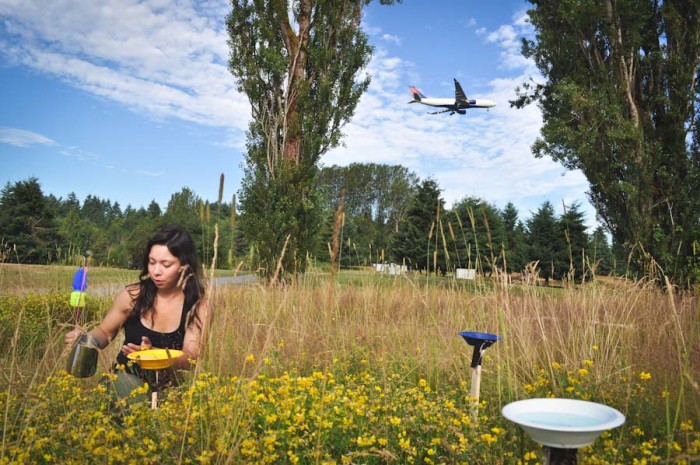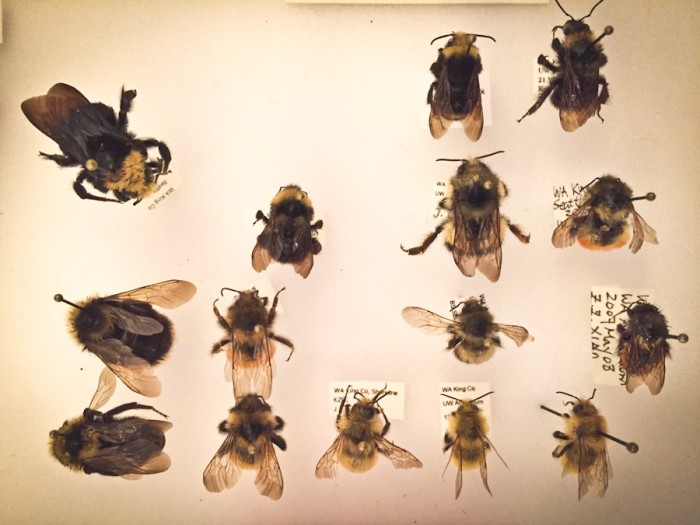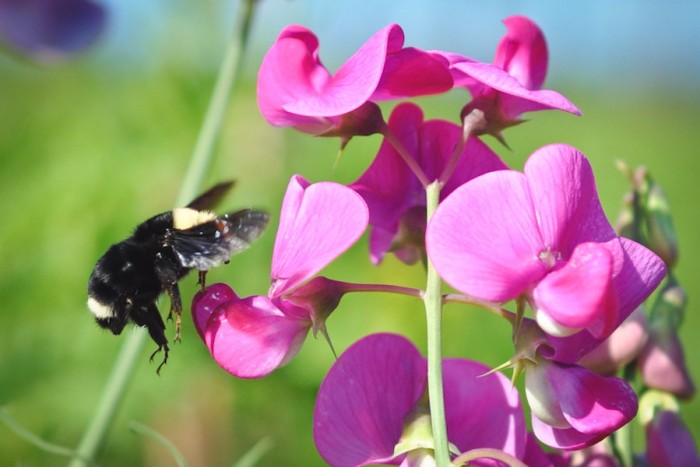
A honeybee colony hums in the open fields beneath Sea-Tac airport flight path, while planes drone overhead.
There’s been a lot of media buzz over bees’ recent disappearing act. And while it may not seem like it on first thought, there’s a lot urban areas can do to help this globally important insect.
Airports in particular are home to a lot of open land, and local nonprofit Common Acre is thinking of creative ways to reclaim green spaces like it and restore it for bee habitat.
Common Acre pitched its centerpiece project “Flight Path” to the Port of Seattle in 2011. The project began with honeybee hives. But a habitat restoration component that involves planting native plants that bees like — goldenrod, big leaf maples, rhododendron — has stolen the narrative.
“The bee hives, fascinating and visible, have been the poster child for things that are ailing the food system,” says Bob Redmond, founder of Common Acre. “Ironically, though, they might not be the answer.”
He’s referring to the potential of native bee species to help pollinate our food system — a role that has long been dominated by honeybees.
The Birds and the Bees
Just like you learned in biology class, bees and other pollinators help carry pollen from one flowering plant to another, allowing plants to reproduce .Pollination can also occur by wind or water, but even in the case of large-scale commercial agriculture, bees pollinate most crops.
Hence the alarming narrative about honeybee disappearances, which commercial beekeepers started noticing about 10 years ago.
At first dubbed colony collapse disorder (CCD), research has increased attempting to understand the causes of bee losses and find a solution.
Culprits for the bee die off have been named from a popular class of pesticides called neonics, parasites, pathogens and poor nutrition. Neonics have taken the brunt of the blame with variations of bans on its use in Europe and in select cities and counties in the U.S. and Canada — including Seattle.
Honeybees, originally native to Asia, moved beyond to North Africa and Southern Europe through natural migration. Eventually, they reached North America in the 17th century, brought by European migrants.
Of the 20,000 species of bees in the world, only seven of those are honeybees, explains Redmond. But only one species is used in industrial and backyard agriculture.
“It’s really, really imbalanced. Really our global food production system is dependent on only one species to do all of its pollinating,” he said.
Redmond doesn’t think that the honeybee can really be replaced, but said that at the root of the problem is the “scale of things.” The reliance on the commercial honeybee could mean enormous collapse of agriculture if honeybees continue to decline (see this slideshow). Bees pollinate about one-third of the food we eat and about 80 percent of flowering crops in the U.S.

Native Bee Species to the Rescue?
It’s clear to Redmond that something has to change.
Over the past few years, problems with this over dependence on honeybees have come to public attention. And only recently, said Redmond, is science beginning to turn an eye to the role of native bees in pollinating agriculturally important crops.
As a result, while the honeybee project is a good mascot to catch the public’s attention, possibly more important work for Redmond is finding out what native bees exist here in Seattle and how they can be supported.
To do that, Common Acre has been working with Washington State University over the last year to survey native bees around the airport, so that the Port of Seattle can plant appropriate habitat for them. Like most airports, Sea-Tac has a lot of land surrounding runways that can’t really be used for any other purpose — it’s too loud or would create flight path obstacles. But bees and the plants that support them can live there just fine.
This spring, the Port of Seattle is beginning to plant the first 20 acres of those plants that will fit the diets of the native species that are already at the airport. Many wild bees will only travel a couple hundred meters, said Redmond, so that habitat is all that they get.
“Over time, we’ll look at how those fare, given the plants that we’re planting, and we’ll work toward a real rock solid sustainability plan for that land at the airport.”
Supporting the Bees that Pollinate our Food
Redmond isn’t alone in the interest in native pollinators.
Hobby photographer Will Peterman, who studied pollination ecology in grad school, has been working on surveying the Western bumblebee with other citizen scientists and partnering with scientists at the USDA and the University of Washington.
The Western bumblebee has seen similar decline to the honeybee, but as of 2013, appears to be making a comeback. The important thing about bumblebees is that they can pollinate almost anything and can even pollinate some plants that honeybees cannot, such as tomatoes, peppers and potatoes.
The shifting focus to native pollinators and habitat restoration sets Seattle apart from other beekeeping projects around the globe.
German cities were the first to pioneer beekeeping at airports, though they use the bees to test air quality. Chicago, which was the first airport in the U.S. with an apiary in 2011, was an inspiration for the project, but focus at O’Hare International Airport is actually in training ex-convicts in agricultural skills. All those other projects keep only honeybees, rather than focusing energy on native bees.
“The honeybee is a way to invite people into the dialogue, but now as things evolve, we could maybe have a new focal point and that could be the wild bees and the flowers,” said Redmond. “Ultimately they could be more important for our future.”

Common Acre’s Flight Path has also been a launching pad for other projects in open areas around Seattle and hopefully beyond. Right now, the organization is working with Seattle City Light on restoring native habitat for wild bees (no honeybees) under the power lines in the Creston-Duwamish corridor, which runs from South Seattle to Tukwila.
The organization may also look at highway mediums and cloverleaf interchanges that have green space in the middle. On average, about 30 percent of land in a city is owned by the municipality, said Redmond, who envisions creatively using that space in a way that will aid sustainability.
Redmond also hopes to expand expertise in other cities and has already gotten inquiries from groups in Denver, Baltimore, San Francisco and Los Angeles.
Kirin Bhatti, communication and strategy specialist working with Common Acre, added that going global is a part of the vision.
“We’re definitely trying to build a model that is scale-able,” she said. “How does the Seattle microcosm fit into the larger global [reality]? How do we do our work here so it helps pollinators at the global level?”
Upcoming events for the bee curious:
Paul Stamets at Town Hall: Mushrooms, Bees and Saving the World
Friday, May 1, from 4 to 5:30 p.m.
Paul Stamets, D.Sc (Hon.), is the founder of Fungi Perfecti and Host Defense Organic Mushrooms, and has been a dedicated mycologist for over forty years. His presentation will cover a range of mushroom species and new research showing how mushrooms can help the health of people and planet, including his cutting edge work with bees. Special guest orbé orbé with Miss TangQ will open with a brief table-setting (and brain-expanding!) performance. Tickets are sold out, but Eric Lee-Mäder will be at Town Hall talking bees in June.
Flight Path art exhibit
The ongoing Flight Path art exhibit, is currently on display in Terminal B at the Seattle-Tacoma International Airport. The exhibit located near the Southwest ticketing agent has garnered a lot of followers for Common Acre, said communication and strategy specialist Kirin Bhatti, generating the desired buzz around environmental issues.
“Our whole approach is the intersection of art and agriculture… If we combine the two, we can create more meaningful lasting engagement around environmental issues,” said Bhatti. “There isn’t connection like there used to be. Even in Seattle where people like nature but we have very urban behavior. Our overarching goal is how do we bring that back to folk’s consciousness and re-embed that back into our culture, even an urban culture.”
The art exhibit is moving to Seattle City Hall in May.
This article has been updated to clarify the Port of Seattle’s involvement in developing habitats for native bees at the airport.

